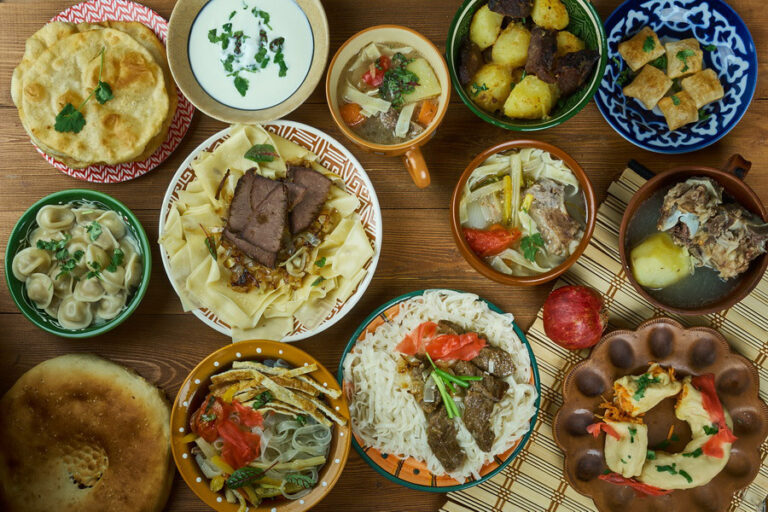Introduction: Kyrgyz Nomadic Traditions
Kyrgyzstan, a Central Asian country, is renowned for its nomadic traditions that have been preserved for centuries. The country’s rich culture is reflected not only in its hospitality and customs, but also in its cuisine. Kyrgyz cuisine is a blend of Turkish, Mongolian, and Russian influences, yet it remains distinct and unique in its own right. The Kyrgyz people have retained their nomadic lifestyle, and their cuisine is still influenced by their traditions, climate, and environment.
The Importance of Food in Kyrgyz Culture
Food plays a crucial role in Kyrgyz culture, and it is a way of expressing hospitality, generosity, and respect. The Kyrgyz people believe that guests are a gift from God, and therefore, they treat them with the utmost care and attention. Meals in Kyrgyz culture are often shared around a communal table called a dastarkhan, and guests are served a variety of dishes, including meat-based stews, soups, and flatbreads. Food is not only a source of nourishment but also a symbol of unity, celebration, and identity in Kyrgyz culture.
Nomadic Traditions and Food Preservation
Kyrgyzstan’s harsh climate and nomadic lifestyle have influenced the preservation methods used in Kyrgyz cuisine. The Kyrgyz people have traditionally used drying, smoking, and salting to preserve their food, which allows them to store it for long periods without refrigeration. Drying is a popular preservation method for fruits, vegetables, and meat, and it is used to make beshbarmak, a traditional dish of boiled meat served on top of flat noodles. Smoking and salting are used to preserve meat, especially during the winter months, when fresh meat is scarce.
Animal Husbandry and Meat-based Dishes
Animal husbandry is an essential component of Kyrgyz nomadic traditions, and meat is a staple in their cuisine. The Kyrgyz people raise sheep, goats, cows, horses, and yaks, and they use every part of the animal in their cooking. Meat-based dishes such as plov, a rice pilaf with lamb or beef, and kuurdak, a stew made with lamb or beef, potatoes, and onions, are popular in Kyrgyz cuisine. Beshbarmak, mentioned earlier, is also often made with lamb or beef.
Dairy Products and Fermented Beverages
Dairy products such as kumis, a fermented drink made from mare’s milk, and ayran, a yogurt-based drink, are popular in Kyrgyz cuisine. Kumis is often consumed during festive occasions and is believed to have medicinal properties. Another fermented beverage is shubat, made from camel’s milk, which is considered a delicacy in Kyrgyzstan. Dairy products are also used in cooking, such as in qurutob, a dish made with vegetables, bread, and yogurt.
Spices and Herbs in Kyrgyz Cuisine
Spices and herbs play a vital role in Kyrgyz cuisine, adding flavor and aroma to dishes. Cumin, coriander, and black pepper are commonly used in meat-based dishes, while dill and parsley are used in salads and soups. Mint is used in teas and other beverages, and it is also added to beshbarmak for an extra flavor kick. Other popular herbs and spices include bay leaves, turmeric, and garlic.
In conclusion, Kyrgyz nomadic traditions have had a significant influence on the country’s cuisine. The emphasis on hospitality, preservation, and animal husbandry has shaped the way Kyrgyz people prepare and consume their food. From meat-based dishes to dairy products and fermented beverages, Kyrgyz cuisine offers a unique blend of flavors and aromas that reflect the country’s rich culture and traditions.

